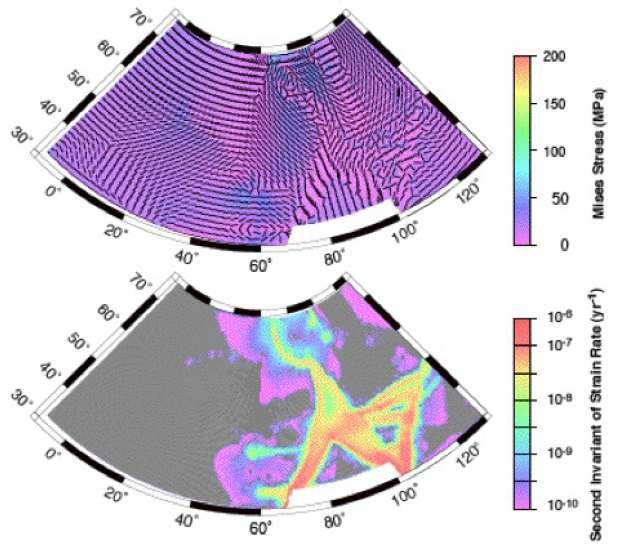Stress, Deformation and Seismicity
The relation between crustal stress, strain and the occurrence of seismicity is the subject of much research done in order to better characterize seismic hazard. We have been working on better characterizing tectonics, and linking these insights to possible earthquake recurrence rates. After my PhD work which looked at stress, temperatures and seismicity along the San Andreas fault and its northernmost end at the Mendocino Triple Junction, in recent years we have focussed on Europe and especially the Mediterranean. Seismic and geodetic strain rate estimates have been combined to obtain better constraints on earthquake recurrence rates in slowly deforming regions. With dynamic models we have been working on better understanding plausible stress and strain distributions in Eurasia
 Eurasia Plate model with damage rheology. Top: Magnitude of Mises stress (shading) and direction of most compressive horizontal stress (ticks). Bottom: Magnitude of second invariant of strain rate. This type of rheology results in strong concentration of deformation in regions of high damage. Indian convergence takes place at such low stress levels that the overall stress field shows little influence of continent-continent collision. High damage and regional forcing result in variations in stress orientation. From Hieronymus et al. (2008)
Eurasia Plate model with damage rheology. Top: Magnitude of Mises stress (shading) and direction of most compressive horizontal stress (ticks). Bottom: Magnitude of second invariant of strain rate. This type of rheology results in strong concentration of deformation in regions of high damage. Indian convergence takes place at such low stress levels that the overall stress field shows little influence of continent-continent collision. High damage and regional forcing result in variations in stress orientation. From Hieronymus et al. (2008)
Related Publications
- Hieronymus, C.F., S. Goes, M. Sargent, G. Morra (2008), A Dynamical Model for Generating Eurasian Lithospheric Stress and Strain Rate Fields: Effect of Rheology and Cratons J. Geophys. Res., in press.
- S. Jenny, S. Goes, D. Giardini, H-G. Kahle (2006) Seismic potential of Southern Italy,Tectonophysics 415, 81-101.
- S. Goes, D. Giardini, S. Jenny, C. Hollenstein, H-G. Kahle, A. Geiger (2004) A recent tectonic reorganization in the South-Central Mediterranean, Earth Planet. Sci. Lett., 225, 335-345.
- S. Jenny, S. Goes, D. Giardini, H-G. Kahle (2004) Earthquake recurrence parameters from seismic and geodetic strain rates in the eastern Mediterranean, Geophys. J. Int. 157, 1331-1347.
- Ch. Hollenstein, H.-G. Kahle, A. Geiger, S. Jenny, S. Goes, D. Giardini (2003), New GPS constraints on the Africa-Eurasia plate boundary zone in southern Italy, Geophys. Res. Lett., 30(18), 1935, doi:10.1029/2003GL017554.
- S. Goes, J.J.P. Loohuis, M.J.R. Wortel and R. Govers (2000), The effect of plate stresses and shallow mantle temperatures on tectonics of northwestern Europe, Glob. Planet. Change 27, 23-38.
- C. Kreemer, W. Holt, S. Goes and R. Govers (2000, Active deformation in eastern Indonesia and the Philippines from GPS and seismicity data, J. Geophys. Res. 105, 663-680.
- Goes, S.D.B. and S.N. Ward, (1994), Synthetic seismicity for the San Andreas Fault, Annali di Geofisica, XXXVIII, N 6., 1495-1513.
- Ward, S.N. and S.D.B. Goes, (1993) How regularly do earthquake recur? A synthetic seismicity model for the San Andreas Fault, Geophys. Res. Lett. 20, 2131-2134.
Associated Personel
Saskia Goes, Louisa Tsang
Recent Collaborators
Chris Hieronymus (Uppsala), Gabriele Morra (ETH Zurich, Roma Tre), David Jackson (UCLA), Domenico Giardini (ETH Zurich), Klaus Regenauer-Lieb (Perth)